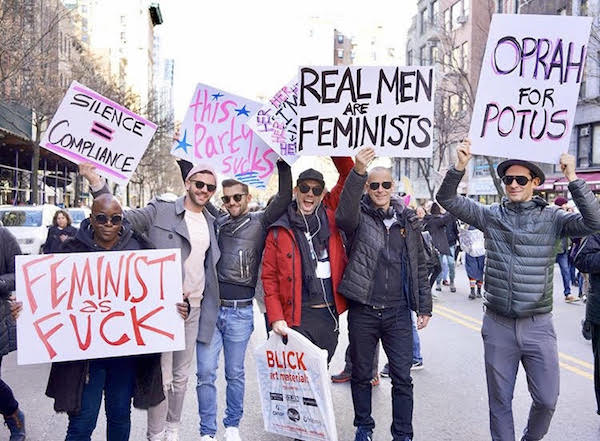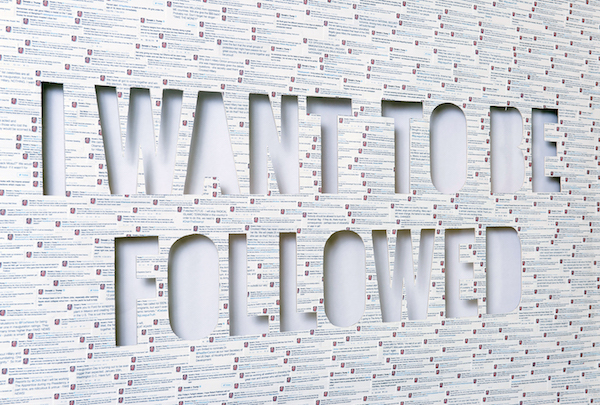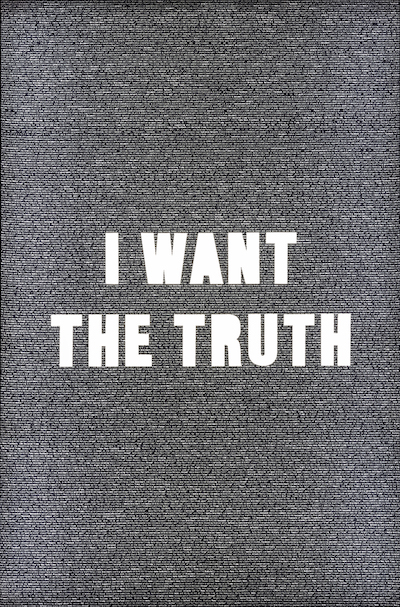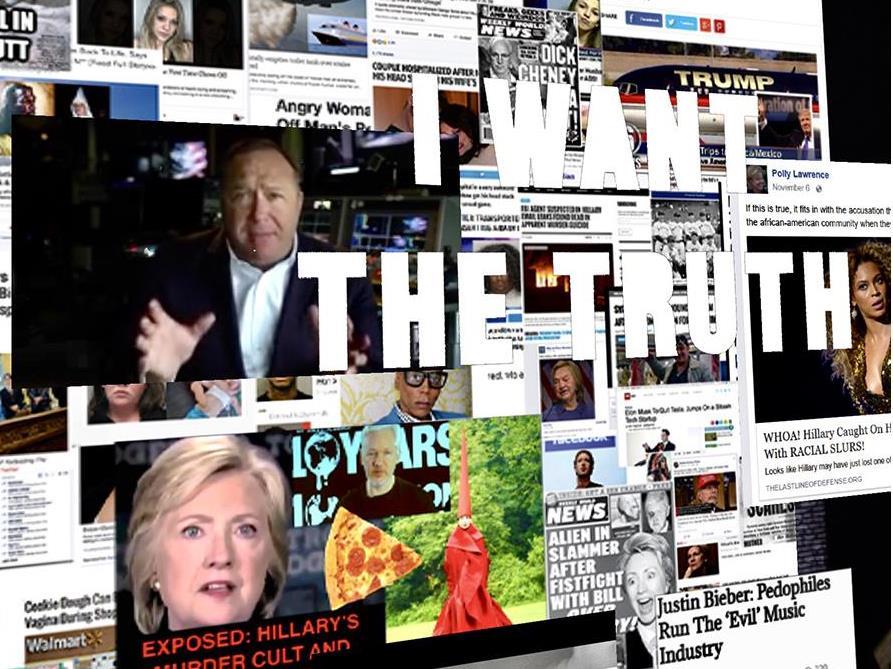Jonathan Rosen, I WANT THE TRUTH (Breitbart), 2018, detail; mixed media; Image courtesy the artist
Art can enhance society as a whole. It can change lives and can act as a catalyst for cultural shifts. In times of uncertainty this is important to remember.
I believe that due to some hapless parallels, artists in Australia and the USA are today, simultaneously making these canons sacrosanct through their actions and work.
It feels like we’ve been watching American political escapades in flabbergast: ‘How did that effigy actually get into a governmental position? How can such an egotist wield power over things he doesn’t understand, is the political system so flawed, or does it reflect such a flawed culture?’
American politics has been labelled as the manifestation of some ghastly reality TV show. However there’s been another tumultuous political system simmering in the background and reaching its boiling point this year, challenging Trump and Brexit for highest viewer ratings.
Australian Politics topped global news stands with headlines such as, Four reasons why Australian politics is so crazy. (BBC News). The world turned its eyes away from the ‘reality TV’ escapades of ‘the orange faced’ celebrity to gape at the drama series of warfare, backstabbing and treachery rolling out as Australian media aired its political ‘blood sport’.
What we asked of the USA, the world began to ask of Australia: “How can a prosperous, democratic nation with a strong economy suffer from such unrelenting political instability?”
The media frenzied turmoil surrounding government figures is not the only place we can draw political parallels between the USA and AUS. We can quickly flick through the not-so-recent history books and reflect on issues of border policy, white supremacy, LGBT and women’s rights to see there are counterparts between these two Western countries of freedom, privilege and entitlement.
Trump’s build a wall tactics can be likened to assiduous references of the White Australia Policy and Abbott’s proclamation “STOP THE BOATS!”(news.com.au)
The plight of Native Americans can be compared to the obliteration of Aboriginal rights, land and heritage. The ongoing and relentless battle for LGBT acceptance is alike around the world. And let’s not forget the misogynist comments of the ostracized Trump and those of Australia’s previous Minister for Women in his addresses to “The Housewives of Australia”.
This is beginning to sound like a solely negative iteration. However, there are also important positives to be drawn here. Both the USA and Australia are home to sundry artists arising in retaliation to flawed politics, to democracy being rendered powerless by political bickering, personal vendettas or egotistical goals. Rising in reproach of media monopolies and fake news.
The USA leads by example, taking inspiration from historical icons to from the 60s, 70s and 80s. The illustrious words of Philip Guston in the 1970s spring to mind…
What was happening in America, the brutality of the world. What kind of man am I, sitting at home, reading magazines, going into frustrated fury about everything – and then going into my studio to adjust a red to a blue? I thought there must be some way I could do something about it. – Philip Guston
Australia is also taking heed and both countries are producing contemporary artists who are compelled to speak politically through their work and their actions.
This month, Arts bodies protesting in Washington DC successfully saw the Mayor rescind amendments that threatened “artistic freedom”. Meanwhile Richard Bell, arguably Australia’s most politically engaged artist has been awarded the Gold Award for Contemporary Art, the country’s richest prize.
Untitled 2018, is described by The Bulletin as an exploration of “complex artistic and political problems of Western, colonial and Indigenous art production and its reception.” Interestingly, the work mimics the styles of two great American artists – Roy Lichtenstein and Jackson Pollock.
In the USA, the artist run Super PAC (Political Action Committee), For Freedoms, is sweeping the country with a public gallery of Billboards aimed to help people become more deeply engaged in politics. Sydney’s ARTSPACE is in the midst of participation in 52 Artists, 52 Actions, which engages politically vocal artists across Asia.


Billboard on Highway 80 outside Pearl, Mississippi displaying the President-elected slogan Make America Great Again over an iconic photograph of the Civil Rights Movement, taken in 1965 by Spider Martin and titled Two Minute Warning. Photo: For Freedoms
And in September, Steve Lambert, founder of the New York-based Center for Artistic Activism (C4AA), was a key speaker at symposium Acting Out: Art that Changes the World, at Wheeler Centre, Melbourne Fringe and Arts House.
It’s rousing to see that artists from both countries are acknowledging that the relationship between art, society and politics are undeniable, a point that Iain Robertson makes in his book Understanding the Markets: Inside the world of art and business, (Routledge).
Jonathan Rosen, a visual artist who works with mixed-media collage and interactive digital technologies, was born in NYC where he currently lives and works. He also holds Australian Permanent Resident status after living in Sydney for several years. He has an upcoming exhibition with Olsen Gruin, the New York sister gallery to Sydney’s Olsen Gallery.

Artist Jonathon Rosen and fellow artists protesting at NYC’s Woman’s March, Jan 20, 2018. From left to right: Dr. Shelly Eversley, Seth Taylor, Josh Appelbaum, German Carmona, Mark Grundy, and Jonathan Rosen.
Living in the USA again, Rosen has been compelled to bring a political voice into his work because “they need me”, he says, “today’s artist activists in America are out in full-force with momentum to be as vocal and impactful as the artists from the 60’s/70’s Vietnam/Civil Right movement such as Peter Saul or the mid-80s AIDs epidemic like Keith Haring.”

Jonathan Rosen, I WANT TO BE FOLLOWED, 2017 (detail), mixed media; image courtesy the artist and Olsen Gruin Gallery
Rosen’s piece I WANT TO BE FOLLOWED is a collage made up of hundreds of Donald Trump tweets from when he announced his candidacy until his inauguration. Gritty and witty, the work is a direct confrontation of Trump’s narcissism. It’s companion piece, I WANT TO FOLLOW, which is simply made from sheep’s wool, is an ironic, emblematic representation of society’s inertia.
A separate piece, I WANT THE TRUTH, is a Lightbox with source code (picture below) taken from right-wing conspiracy theory site Breitbart News. When applied to the piece, Augmented Reality reveals some of the biggest fake news stories to date (picture top).

Jonathan Rosen, I WANT THE TRUTH (Breitbart), 2018, mixed media; Image courtesy the artist and Olsen Gruin Gallery
I am drawn to the comments by writers who recognise this intersection of moment and action. ‘We need courageous artists to make great political art of our time,’ proclaimed Ben Luke in a recent article in The Art Newspaper (‘In these darkest of times, what the world needs is great political art’, The Art Newspaper, Number 297, January 2018), while Australian Philosopher McKenzie Wark, in an interview with e-flux magazine’s podcast reminded us that ‘artists are the antenna of our time.’
There are many examples of artists on both sides of the Pacific pushing boundaries, breaking new ground and having actual effect in calling policy makers to attention. From movements sweeping American and Australasia, to simple acts such as creating slogan banners for marches; artist, collectives, curators, dealers and galleries need to persist in making statements and taking action that holds political administrations to account.
I believe that Australian artists should continue looking to our creative friends across the water in support, commiseration and over all for mutual inspiration and motivation in this shared time of political, social, cultural and geographical upheaval.





